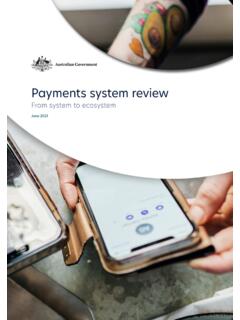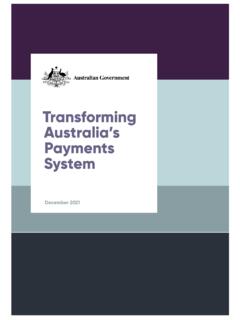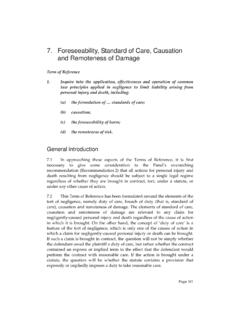Transcription of Crypto asset secondary service providers: Licensing and ...
1 Crypto asset secondary service providers: Licensing and custody requirements Consultation paper 21 March 2022. Commonwealth of Australia 2022. This publication is available for your use under a Creative Commons Attribution Australia licence, with the exception of the Commonwealth Coat of Arms, the Treasury logo, photographs, images, signatures and where otherwise stated. The full licence terms are available from Use of Treasury material under a Creative Commons Attribution Australia licence requires you to attribute the work (but not in any way that suggests that the Treasury endorses you or your use of the work). Provided you have not modified or transformed Treasury material in any way including, for example, by changing the Treasury text; calculating percentage changes; graphing or charting data; or deriving new statistics from published Treasury statistics then Treasury prefers the following attribution: Source: The Australian Government the Treasury.
2 Derivative material If you have modified or transformed Treasury material, or derived new material from those of the Treasury in any way, then Treasury prefers the following attribution: Based on The Australian Government the Treasury data. Use of the Coat of Arms The terms under which the Coat of Arms can be used are set out on the Department of the Prime Minister and Cabinet website (see ). Other uses Enquiries regarding this licence and any other use of this document are welcome at: Manager Media and Speeches Unit The Treasury Langton Crescent Parkes ACT 2600. Email: Contents Consultation Process ..1. Request for feedback and comments ..1. Regulation of Crypto asset secondary service providers ..2. Existing regulatory framework ..7. Proposed terminology and definitions ..10. Terminology changes ..10. Proposed definitions.
3 10. Proposed principles, scope and policy objectives of the new regime ..12. Proposed obligations on Crypto asset secondary service Rationale for the proposal ..16. Proposed Financial Prohibition on hawking or pressure selling Crypto assets ..17. Alternative options ..18. Alternative option 1: Regulating CASSPrs under the financial services regime ..18. Alternative option 2: Self-regulation by the Crypto industry ..19. Proposed custody obligations to safeguard private keys ..20. Rationale for the proposal ..20. Proposed Alternate option: Industry self-regulation ..21. Early views sought on token mapping ..23. Specifying classes of Crypto assets ..23. Appendix 1 Overview of Australian Crypto asset regulation ..25. Appendix 2 Custody obligations in relation to scheme assets ..28. Crypto asset secondary service providers: Licensing and custody requirements Consultation Process Request for feedback and comments Closing date for submissions: 27 May 2022.
4 Email Director Crypto Policy Unit Mail Financial System Division The Treasury Langton Crescent PARKES ACT 2600. Enquiries Enquiries can be initially directed to Director Crypto Policy Unit Phone 02 6263 3416. The principles outlined in this paper have not received Government approval and are not yet law. As a consequence, this paper is merely a guide as to how the principles might operate. 1. Crypto asset secondary service providers: Licensing and custody requirements Regulation of Crypto asset secondary service providers Introduction The Crypto asset ecosystem has expanded rapidly in recent years, growing by times in 2021 to US $ trillion. 1 More than 800,000 Australian taxpayers have transacted in digital assets in the last three years, with a 63 per cent increase in 2021 compared with 2020. 2. This surge in retail consumer exposure to Crypto assets has led to calls, including from some service providers, for additional regulation in Australia.
5 Regulation would support consumer confidence and trust in the Crypto asset ecosystem and provide regulatory certainty to support Crypto businesses'. investment decisions. On 8 December 2021, the Government announced that it would consult on approaches to licencing digital currency exchanges and consider custody requirements for Crypto assets, with advice to be provided to Government on policy options by mid-2022. 3 This consultation paper outlines the Government's proposed approach to Licensing Crypto asset secondary service providers 4 (CASSPrs). and Crypto custody requirements. The proposals in this paper recognise the growing importance of the Crypto asset ecosystem to both the Australian and global economy, the need for regulatory certainty to encourage innovation and competition, and seeks to give consumers greater confidence in their dealings with CASSPrs.
6 What is a Crypto asset ? A Crypto asset is a digital representation of value that can be transferred, stored, or traded electronically. Crypto assets use cryptography and distributed ledger technology. Today, Crypto assets have three primary uses: as an investment; as a means of exchange; and to access goods and services. Crypto assets include cryptocurrencies like BTC, Ripple and Litecoin, utility tokens like filecoin and basic attention token, and security tokens. They may run on their own Blockchain or use an existing platform like Ethereum. Crypto assets may also include non-fungible tokens (NFTs). Crypto assets are a subset of digital assets, that uses cryptographic proof to determine ownership. The Crypto ecosystem is a dynamic and expansive ecosystem with many players in the primary and secondary market (Figure 1). This consultation paper considers the regulation of centralised CASSPrs who offer Crypto asset custody, storage, brokering, exchange and dealing services, or operate a market in Crypto assets for retail consumers.
7 1. Financial Stability Board, Assessment of Risks to Financial Stability from Crypto -assets, FSB, 2022, accessed 8. March 2022. 2. Australian Taxation Office (ATO). 3. This was announced in response to the Senate Select Inquiry on Australia as a Financial and Technology Innovation Centre's Final Report (released on 20 October 2021). The first two recommendations in the report were to introduce a Licensing regime for digital currency exchanges and a custody regime for entities holding digital assets on behalf of a client. 4. This is a broad term intended to capture both digital currency exchanges in Australia and other Crypto asset service providers including brokers, dealers, exchanges, and Crypto asset markets. The proposed definition is based on the definition of a Virtual asset service Provider as defined by the Financial Action Task Force.
8 2. Crypto asset secondary service providers: Licensing and custody requirements Figure 1: Simplified structure of the ecosystem for Crypto assets (adapted from Ankenbrand et al (2021)). 5. This paper also seeks early views on how to categorise and classify Crypto assets to provide more certainty to Crypto asset secondary service providers, consumers, and regulators. Consistent with the Government's response to the Senate Report, a token mapping process will be completed as a separate piece of work and finalised by the end of year. Feedback provided to this section of the paper will be considered as part of a future consultation process. The Government is keen to harness the economic benefits from the technological innovations arising from the Crypto ecosystem for Australia and create a local Crypto ecosystem that consumers can trust.
9 This will need to be done while managing the risks Crypto assets could present to consumers, the financial system, and the real economy. Structure of the paper This paper is structured in four parts. The first part of the paper outlines the current state of the Crypto asset ecosystem, including the existing regulatory environment. The second part of the paper proposes for consideration and feedback a Licensing regime for CASSPrs, establishing the potential scope and obligations on providers. The third part of the paper discusses custody obligations to safeguard private keys. The final part of the paper seeks early views on the classification of Crypto assets, noting further consultation will follow on this aspect later in 2022. The Government welcomes views on each of the proposals. 5. Ankenbrand et al, Crypto Assets Study 2021 An overview of the Swiss and Liechtenstein Crypto assets ecosystem, Institute of Financial Services Zug IFZ, 2021, accessed on 17 December 2021.
10 3. Crypto asset secondary service providers: Licensing and custody requirements Background The emergence of a virtual economy The Crypto asset industry has expanded rapidly, with consumer interest increasing commensurately. For example, in December 2021, Independent Reserve found that more than 28 per cent of Australians surveyed own Crypto assets. 6 This emerging virtual economy has expanded beyond the original use case of trustless digital currency, with growth in areas as disparate as gaming, art, real estate, lending and security. Crypto assets and blockchain technology are also permeating traditional industries. For example, across the public and private sector in Australia: ASX is replacing its Clearing House Electronic Subregister System (CHESS) with distributed ledger technology;. Australian mining company Rio Tinto used blockchain to facilitate the trade of iron ore to a foreign country; and three of Australia's four major banks partnered with IBM and Scentre Group to issue the first digital bank guarantee for retail property leases on blockchain earlier this year.









